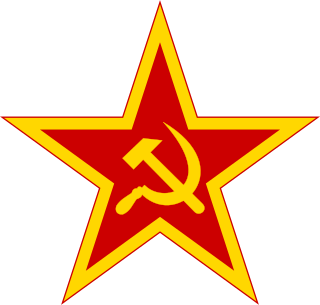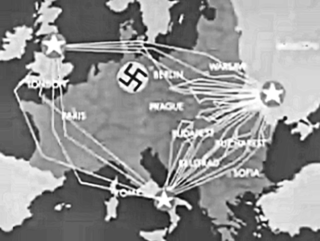
The Warsaw Pact (WP), formally the Treaty of Friendship, Cooperation and Mutual Assistance (TFCMA), was a collective defense treaty signed in Warsaw, Poland, between the Soviet Union and seven other Eastern Bloc socialist republics of Central and Eastern Europe in May 1955, during the Cold War. The term "Warsaw Pact" commonly refers to both the treaty itself and its resultant defensive alliance, the Warsaw Treaty Organization (WTO). The Warsaw Pact was the military and economic complement to the Council for Mutual Economic Assistance (Comecon), the regional economic organization for the Eastern Bloc states of Central and Eastern Europe.
A puppet state, puppet régime, puppet government or dummy government is a state that is de jure independent but de facto completely dependent upon an outside power and subject to its orders. Puppet states have nominal sovereignty, except that a foreign power effectively exercises control through economic or military support. By leaving a local government in existence the outside power evades all responsibility, while at the same time successfully paralyzing the local government they tolerate.

The term "Soviet empire" collectively refers to the world's territories that the Soviet Union dominated politically, economically, and militarily. This phenomenon, particularly in the context of the Cold War, is also called Soviet imperialism by Sovietologists to describe the extent of the Soviet Union's hegemony over the Second World.
Following the termination of hostilities in World War II, the Allies were in control of the defeated Axis countries. Anticipating the defeat of Germany and Japan, they had already set up the European Advisory Commission and a proposed Far Eastern Advisory Commission to make recommendations for the post-war period. Accordingly, they managed their control of the defeated countries through Allied Commissions, often referred to as Allied Control Commissions (ACC), consisting of representatives of the major Allies.

The Western Group of Forces (WGF), previously known as the Group of Soviet Occupation Forces in Germany (GSOFG) and the Group of Soviet Forces in Germany (GSFG), were the troops of the Soviet Army in East Germany. The Group of Soviet Occupation Forces in Germany was formed after the end of World War II in Europe from units of the 1st and 2nd Belorussian Fronts. The group helped suppress the East German uprising of 1953. After the end of occupation functions in 1954 the group was renamed the Group of Soviet Forces in Germany. The group represented Soviet interests in East Germany during the Cold War. Before changes in Soviet foreign policy during the early 1990s, the group shifted to a more offensive role and in 1989 became the Western Group of Forces. Russian forces remained in the eastern part of Germany after the dissolution of the Soviet Union and German reunification until 1994.

The Soviet Armed Forces, also known as the Armed Forces of the Soviet Union, the Red Army (1918–1946) and the Soviet Army (1946–1991), were the armed forces of the Russian SFSR (1917–1922) and the Soviet Union (1922–1991) from their beginnings in the Russian Civil War of 1917–1923 to the collapse of the USSR in 1991. In May 1992, Russian President Boris Yeltsin issued decrees forming the Russian Armed Forces, which subsumed much of the Soviet Armed Forces. Multiple sections of the former Soviet Armed Forces in the other, smaller Soviet republics gradually came under those republics' control.

Vasiliy Ivanovich Petrov was a Soviet and Russian military official and Marshal of the Soviet Union. He served as Commander of the Soviet Ground Forces from 1980 to 1985.

The Soviet occupation of Romania refers to the period from 1944 to August 1958, during which the Soviet Union maintained a significant military presence in Romania. The fate of the territories held by Romania after 1918 that were incorporated into the Soviet Union in 1940 is treated separately in the article on Soviet occupation of Bessarabia and Northern Bukovina.

Operation Frantic was a series of seven shuttle bombing operations during World War II conducted by American aircraft based in Great Britain and southern Italy, which landed at three Soviet airfields in Ukraine. From there, the planes flew bombing missions en route back to their bases in Italy and Great Britain.

The Baltic Military District was a military district of the Soviet armed forces in the Baltic states, formed shortly before the German invasion during World War II. After the end of the war the Kaliningrad Oblast was added to the District's control in 1946, and the territory of Estonia was transferred back to the Baltic Military District from the Leningrad Military District in 1956. The Baltic Military District was disbanded after the fall of the Soviet Union in 1991 and reorganised into the North Western Group of Forces, which ceased to exist following the withdrawal of all Russian troops from Estonia, Latvia and Lithuania on 1 September 1994.
The Southern Group of Forces (YUGV) was a Soviet Armed Forces formation formed twice following the Second World War, most notably around the time of the Hungarian Revolution of 1956.

During World War II, the Soviet Union occupied and annexed several countries effectively handed over by Nazi Germany in the secret Molotov–Ribbentrop Pact of 1939. These included the eastern regions of Poland, as well as Latvia, Estonia, Lithuania, part of eastern Finland and eastern Romania. Apart from the Molotov–Ribbentrop Pact and post-war division of Germany, the USSR also occupied and annexed Carpathian Ruthenia from Czechoslovakia in 1945.

The Soviet Army or Soviet Ground Forces was the land warfare service branch of the Soviet Armed Forces from 1946 to 1992.

The 392nd Hero of the Soviet Union Marshal of the Soviet Union V. I. Petrov Pacific Red Banner Order of Kutuzov District Training Center is a training formation of the Russian Ground Forces. It is located at Knyaze-Volkonskoye in the Khabarovsk area.

In Soviet historiography, Stalin's ten blows were the ten successful strategic offensives conducted by the Red Army in 1944 during World War II. The Soviet offensives drove the Axis forces from Soviet territory and precipitated Nazi Germany's collapse.

Military aircraft insignia are insignia applied to military aircraft to identify the nation or branch of military service to which the aircraft belong. Many insignia are in the form of a circular roundel or modified roundel; other shapes such as stars, crosses, squares, or triangles are also used. Insignia are often displayed on the sides of the fuselage, the upper and lower surfaces of the wings, as well as on the fin or rudder of an aircraft, although considerable variation can be found amongst different air arms and within specific air arms over time.
The 39th Army was a Field Army of the Soviet Union's Red Army during World War II and of the Soviet Army during the Cold War.

Ivan Nikolaevich Shkadov was an army general of the Soviet Army and a Hero of the Soviet Union.

Soviet involvement in regime change entailed both overt and covert actions aimed at altering, replacing, or preserving foreign governments. In the 1920s, the nascent Soviet Union intervened in multiple governments primarily in Asia, acquiring the territory of Tuva and making Mongolia into a satellite state. During World War II, the Soviet Union helped overthrow many puppet regimes of Nazi Germany and the Empire of Japan, including in East Asia and much of Europe. Soviet forces were also instrumental in ending the rule of Adolf Hitler over Germany.















